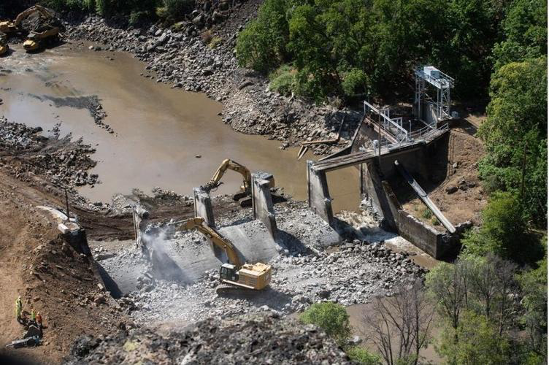Written by Preston Brown, Photos Courtesy of the Klamath River Renewal Corporation
Roughly 350 miles north of Lagunitas Creek in northern California, the largest dam removal project to-date in the world is now underway. The Klamath River is one of the West’s most iconic salmon-bearing rivers, originating in Oregon and meeting the ocean in Humboldt County, California, the Klamath River Watershed is the size of New Jersey. Historically boasting nearly 1 million chinook, coho, and steelhead annually, like many rivers in California, its populations of salmon have plummeted, now only supporting 20,000 – 50,000 spawners annually. Thankfully, that’s all expected to change now that the four dams that have plagued the Klamath River for nearly a century are beginning to come down.
After 35 years of advocacy, negotiations, litigation, and tangled regulatory changes, the four dams on the river were finally transferred to a new owner in 2020, the Klamath River Renewal Corporation. This ownership change created a pathway for the dams to be decommissioned and restoration planning and engineering could begin.
The Yurok Tribe and the Shasta Indian Nation, among other Tribal organizations, have been the strongest advocates for removing the dams and restoring the river. Through decades of advocacy campaigning, regulatory hurdles, litigation, and countless setbacks, the Yurok, Shasta, and other Tribes have shepherded the restoration of the river, often against staggering obstacles. The four dams on the river have historically diverted water out, primarily for hydroelectric power, which depletes flow downstream causing toxic algae blooms and high temperatures – all of which contributed to massive salmon die-offs. The Tribes have often cited the injury to their inherited fishing rights as standing to enter legal challenges that progressed the effort to remove the dams.
Finally, after heroic deal brokering, legal settlement, and regulatory compliance, the smallest of the four dams began being removed. Named Copco Dam 2, this 30 ft tall concrete dam diverted water out of the river to produce hydroelectric energy. Beginning in June 2023, this dam was systemically taken apart. Now in November 2023, the dam is completely removed and the river flows freely where tall concrete bulkheads once stood. This is the first of four to be removed and the remaining three are much larger, including Iron Gate dam, which stands at nearly 200 feet. These other dams will be removed in 2024 and 2025, which will culminate in the largest dam removal project in the world to-date!
The Klamath River restoration is a major victory for wild fish recovery, Tribal rights, and the rights of the river to flow freely. Removal of large dams like the Klamath are rare but represent a significant change in perspective of how our country values rivers, wild fish, and natural resources. More stories like the Klamath River restoration will likely be a more common in the coming century as obsolete dams will take a back seat to wild rivers and wild fish.



